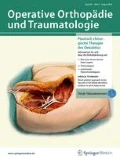Zusammenfassung
Operationsziel
Übungsstabile Osteosynthese instabiler proximaler Humerusfrakturen.
Indikationen
Instabile Humeruskopffrakturen mit zwei bis vier Fragmenten.
Instabile proximale Humerusfrakturen.
Pseudarthrosen des proximalen Humerus.
Kontraindikationen
Stabile proximale Humerusfrakturen (eingestaucht, unter Bildwandlerkontrolle stabil bei der dynamischen Untersuchung).
Luxationsfrakturen mit Zerreißung der den Kalottenanteil ernährenden Gefäße.
Frakturen mit Spaltung des Humeruskopfes („headsplit“).
Relativ: Fehlende knöcherne Umrandung des Nageleintrittspunkts im Kalottenbereich.
Operationstechnik
Darstellung des Nageleintrittspunkts im Kalottenzenit über eine Spaltung des Musculus deltoideus und kurze Inzision der Supraspinatussehne dorsal der Bizepssehne. Geschlossene, gedeckte oder offene Reposition und Entfernung eines Fräszylinders für den Nageleintritt in die Kalotte. Auffädeln des Schafts und Verriegelung des Nagels in der Kalotte mit vier proximalen winkelstabilen Bolzen und im Schaft mit zwei Schrauben über einen Zielbügel. Genaue Kontrolle der Implantatlage mit Bildverstärker zur Vermeidung eines Implantatüberstands. Verschluss der Rotatorenmanschette und transossäre Refixierung des Deltamuskels am Akromion.
Nachbehandlung
Gilchrist-Verband für wenige Tage, bei unkooperativen Patienten für 4 Wochen, damit sich die Patienten nicht mit dem operierten Arm abstützen. Die Außenrotation wird für 6 Wochen auf 15° eingeschränkt. Die übrigen Bewegungsrichtungen sind bis zur Schmerzgrenze freigegeben. Physiotherapeutische Behandlung, um Verklebungen im Subakromialraum zu verhindern.
Ergebnisse
Von Dezember 2000 bis Frühjahr 2004 wurden 137 instabile proximale Humerusfrakturen bei 133 Patienten in einem mittleren Alter von 74,9 Jahren operiert. 97 Patienten mit 99 operierten Schultern wurden nach mindestens 7 Monaten nachuntersucht. Das mittlere Alter der nachuntersuchten Patienten betrug 74,9 ± 13,6 Jahre (20–102 Jahre). Im Constant-Score wurden 60,0 ± 16,8 Punkte und im alters- und geschlechtsadaptierten sowie im seitenadaptierten Constant-Score 84,8 ± 19,4% und 84,0 ± 15,5% erreicht.
Abstract
Objective
Exercise-stable internal fixation of unstable fractures of the proximal humerus.
Indications
Unstable humeral head fractures with two to four fragments.
Unstable fractures of the proximal humerus.
Pseudarthroses of the proximal humerus.
Contraindications
Stable proximal humerus fractures (impacted, dynamic stability confirmed by image intensifier).
Dislocated fractures with rupture of the nutrient arteries to the region of the humeral head.
Fractures with headsplit.
Relative: incomplete or nonexistent bone stock around the nail insertion site in the region of the humeral head.
Surgical Technique
Exposure of the nail insertion site at the apex of the humeral head by division of the deltoid muscle and short incision of the supraspinatus tendon posterior to the biceps tendon. Open or closed reduction and extraction of a cylindrical bone segment ready for nail insertion through the humeral head. The nail is advanced into the humeral shaft and locked in the humeral head with four proximal interlocking screws and into the diaphysis with two fixation screws inserted with the help of the targeting device. Exact monitoring of implant position using the image intensifier to ensure that the implant is not protruding. Closure of the rotator cuff and transosseous refixation of the deltoid muscle to the acromion.
Postoperative Management
Gilchrist bandage for a few days or for 4 weeks in noncompliant patients preventing to lean on the operated arm. External rotation is restricted to 15° for 6 weeks. All other movements are permitted up to the pain threshold. Physiotherapeutic treatment to prevent adhesions in the subacromial space.
Results
From December 2000 to spring 2004, 133 patients (average age: 74.9 years) with 137 unstable proximal humeral fractures were treated surgically. 97 patients with 99 operated shoulders were followed up for at least 7 months. The patients' average age at follow-up was 74.9 ± 13.6 years (20–102 years). A Constant Score of 60.0 ± 16.8 points was achieved and 84.8 ± 19.4% and 84.0 ± 15.5% on the age- and gender-related as well as side-related Constant Scores.
Author information
Authors and Affiliations
Corresponding author
Rights and permissions
About this article
Cite this article
Mathews, J., Lobenhoffer, P. Osteosynthese instabiler proximaler Humerusfrakturen mit dem Targon®-PH-Nagel. Orthop Traumatol 19, 255–275 (2007). https://doi.org/10.1007/s00064-007-1205-7
Issue Date:
DOI: https://doi.org/10.1007/s00064-007-1205-7
Schlüsselwörter
- Antegrade Marknagelung
- Instabile proximale Humerusfraktur
- Winkelstabiles Implantat
- Geriatrischer Patient

